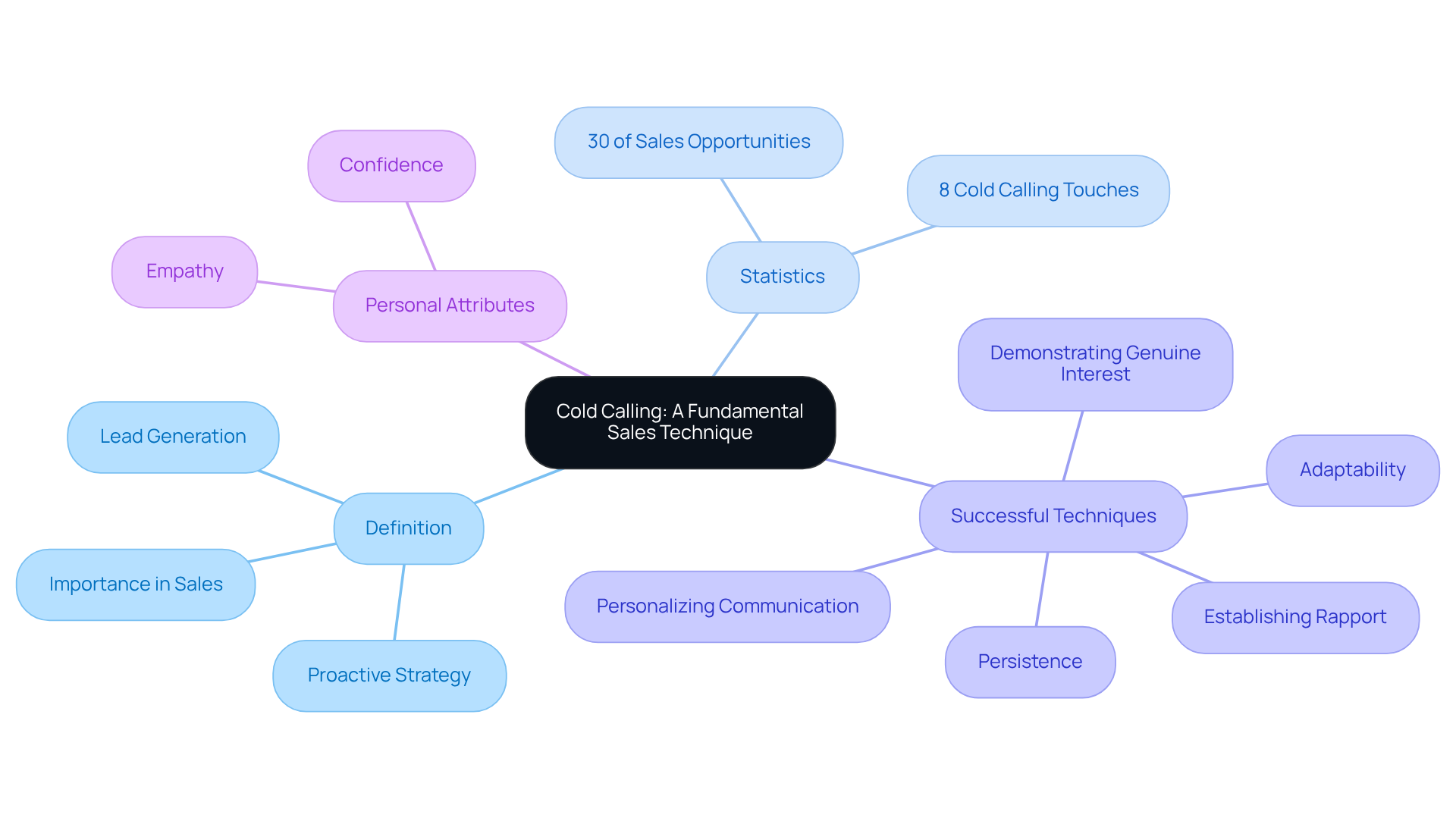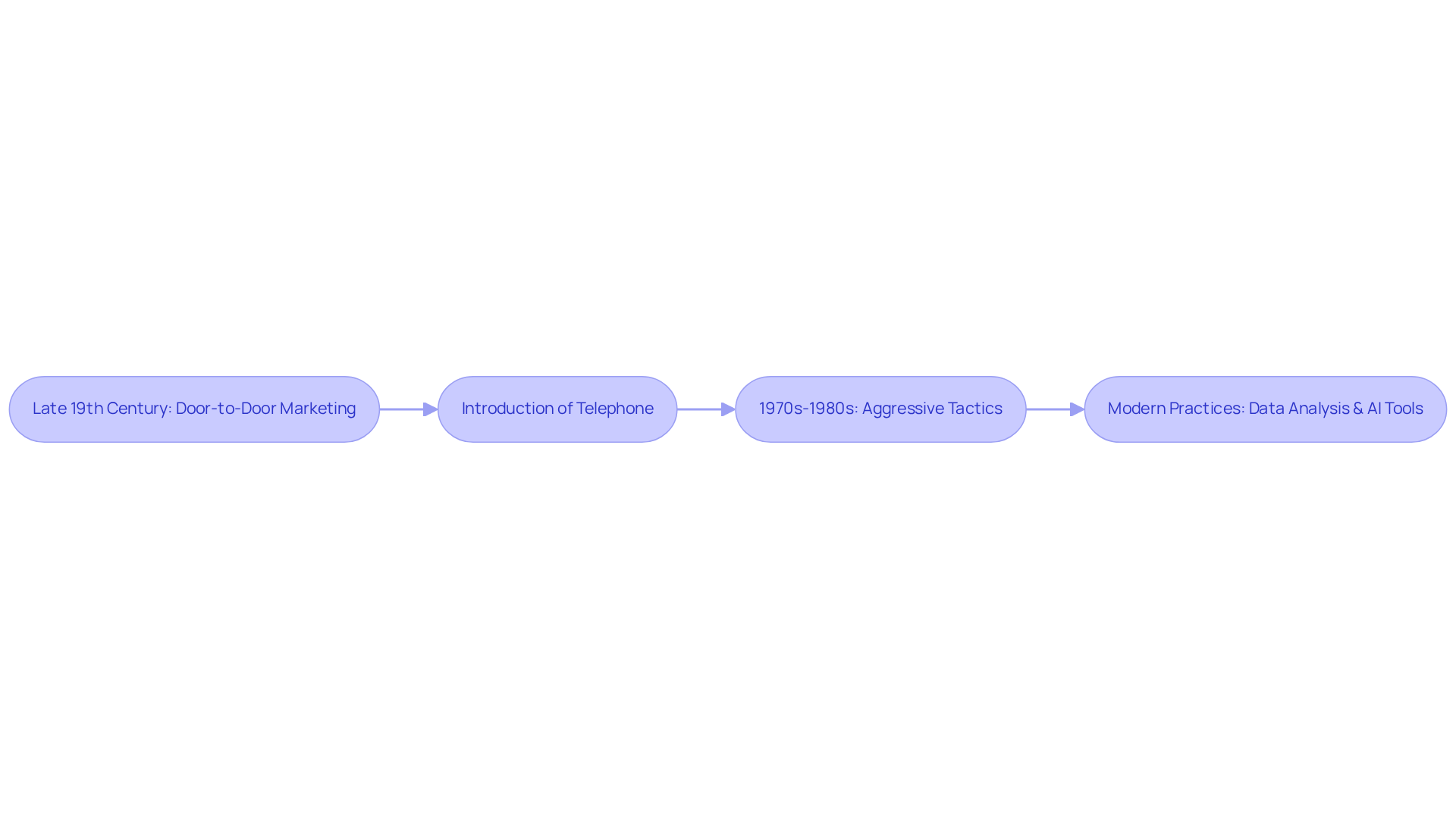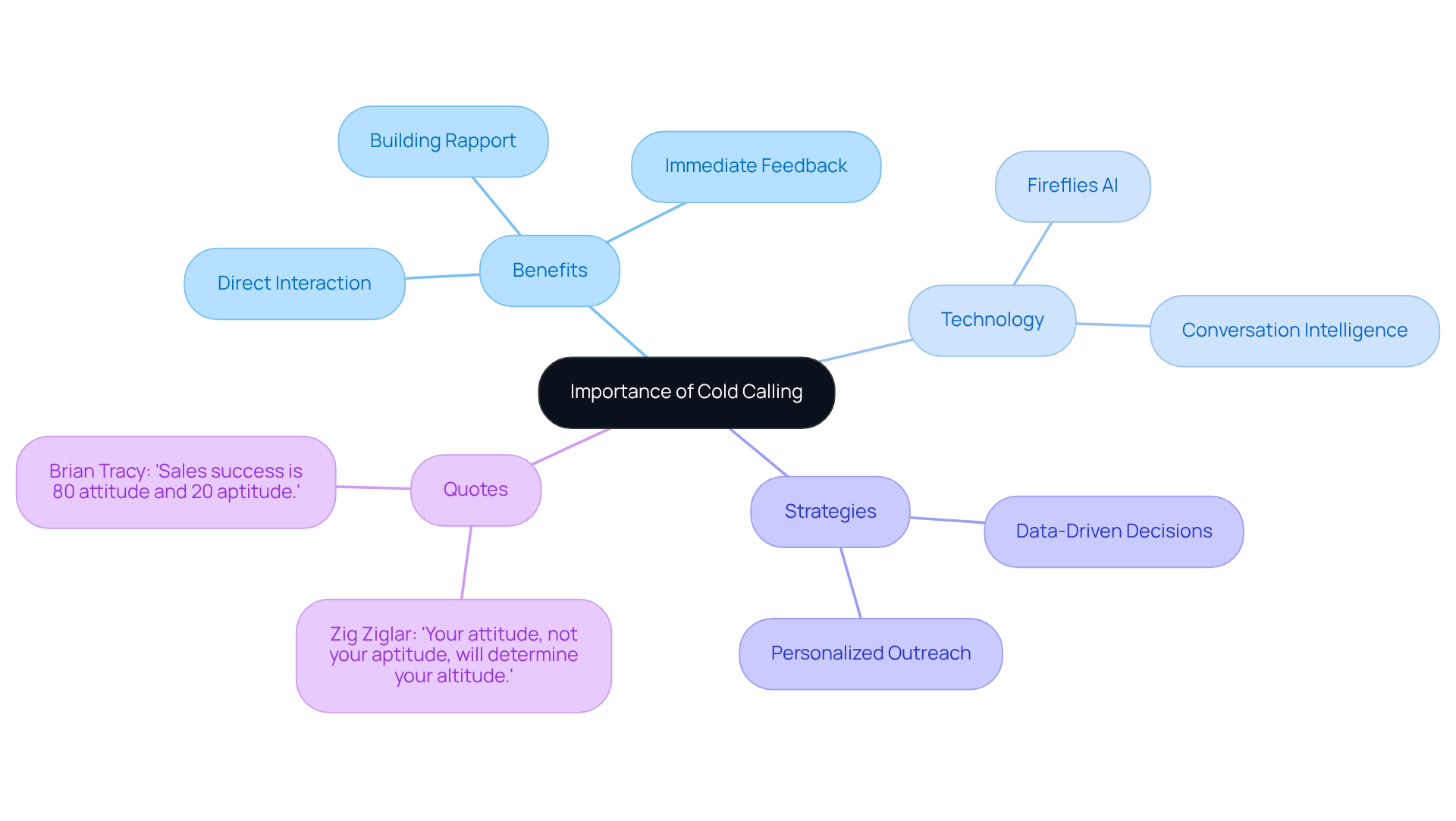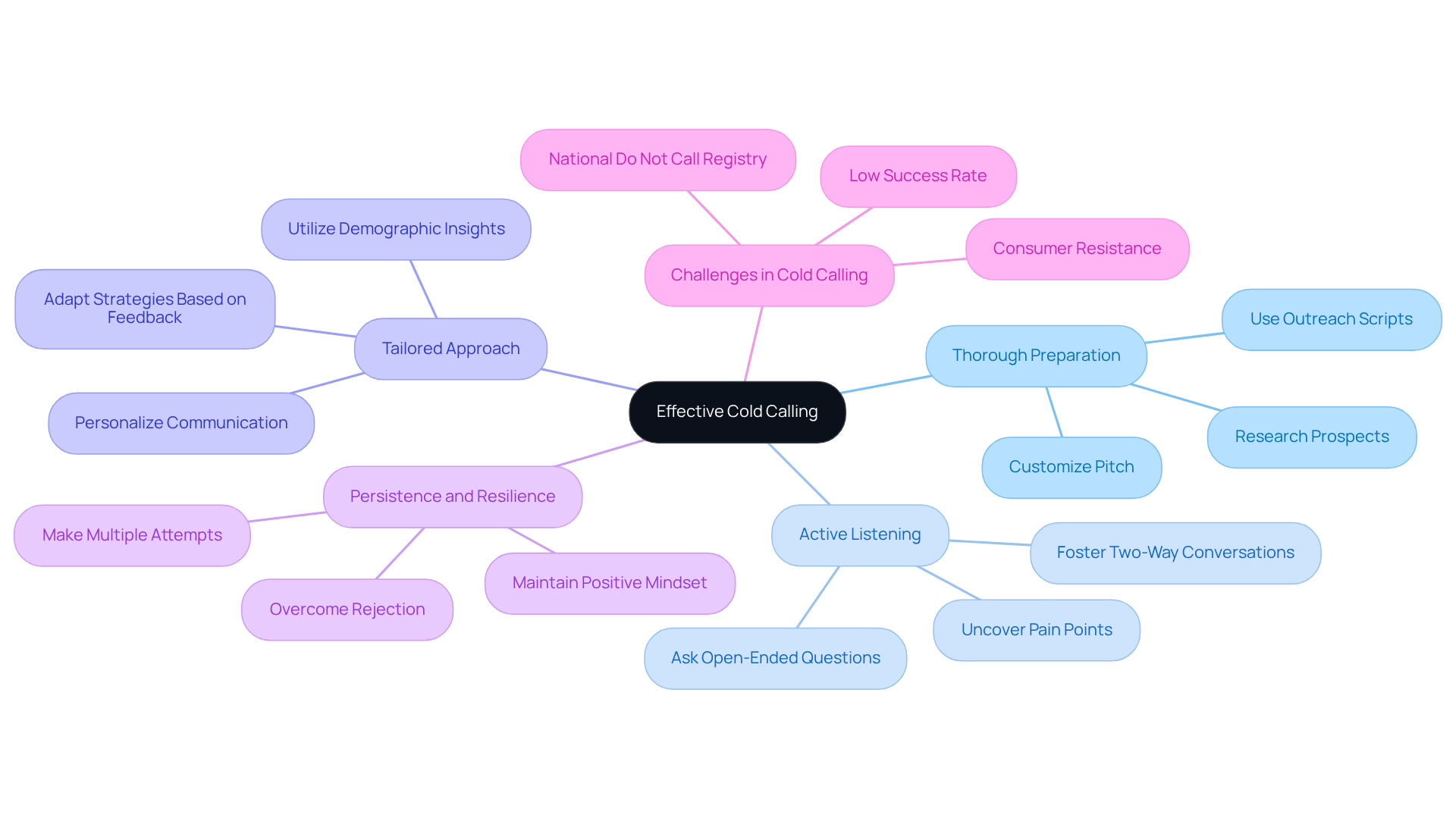
What’s a Cold Call? Understanding Its Importance and Techniques
GeneralOverview
Cold calling stands as a proactive sales technique, crucial for reaching out to prospective clients who have yet to engage with the company. This strategy primarily aims to generate leads and enhance revenue. The article underscores its significance by outlining effective strategies—such as personalization and resilience—that empower sales representatives to:
- Build rapport
- Navigate high rejection rates
- Ultimately achieve sales success
By embracing these strategies, sales professionals can transform challenges into opportunities, driving their performance and the company’s growth.
Introduction
Understanding the intricacies of cold calling is essential for anyone looking to excel in sales. This proactive outreach strategy not only generates leads but also fosters genuine connexions with potential clients, establishing it as a cornerstone of effective sales techniques. Yet, amidst the rise of digital communication, many grapple with a pressing question: how can cold calling be transformed from a daunting task into a powerful tool for engagement and success?
Define Cold Calling: A Fundamental Sales Technique
Cold outreach is often referred to as what’s a cold call, representing a proactive strategy where a representative reaches out to prospective clients who have yet to engage with the company. This method serves primarily to generate leads, showcase products or services, and ultimately enhance revenue. While unsolicited outreach can occur through various channels such as email or face-to-face visits, what’s a cold call is predominantly associated with telephone communication. The primary objective is to initiate a conversation, which is essentially what’s a cold call, that may lead to a transaction, establishing it as a vital element of numerous sales tactics.
In 2025, approximately 30% of sales opportunities will be generated through unsolicited outreach, underscoring its significance in the sales process. Successful outreach techniques hinge on:
- Personalising communication
- Quickly establishing rapport
- Demonstrating a genuine interest in the prospect’s needs
Sales specialists emphasise the importance of confidence and empathy in outreach, with Jill Konrath describing it as a skill that requires both.
Effective outreach strategies necessitate:
- Persistence
- Adaptability
Mark Hunter compares unsolicited outreach to a first date, highlighting the critical nature of making a positive impression. Moreover, the use of motivational quotes can inspire teams to maintain a positive outlook, essential for overcoming the challenges associated with outreach. By mastering these techniques, marketing professionals can significantly enhance their lead generation efforts, thereby contributing to their organisation’s overall success.

Trace the Evolution of Cold Calling: From Traditional Methods to Modern Practices
Unsolicited outreach has its roots in the late 19th century, with early examples linked to door-to-door marketing strategies. This approach evolved over the decades, particularly with the introduction of the telephone. By the 1970s and 1980s, unsolicited outreach became a cornerstone of marketing strategies, often characterised by aggressive tactics and high call volumes. However, as technology advanced, so too did the methods of telemarketing. Today, marketing experts leverage data analysis, CRM platforms, and AI tools to refine their targeting and personalise their outreach efforts, which raises the question of what’s a cold call that is not only more effective but also less intrusive.

Examine the Importance of Cold Calling: Driving Sales Success and Customer Engagement
Whats a cold call? It plays an essential role in achieving revenue by facilitating direct interaction with prospective clients. It empowers representatives to showcase their products, address client pain points, and build rapport. Despite the rise of digital communication methods, many still wonder whats a cold call, as unsolicited outreach remains effective; research indicates that many buyers are still open to receiving calls from representatives. Moreover, telemarketing provides immediate feedback, allowing teams to adjust their strategies in real-time based on client reactions. This personal touch can foster stronger relationships and enhance conversion rates.
With over 4.02 billion internet users today, the potential reach of cold calling efforts is substantial. Case studies demonstrate that organisations employing effective communication tools, such as Fireflies AI’s conversation intelligence, have seen notable improvements in client engagement and revenue outcomes. Fireflies AI tracks critical metrics from client meetings, offering insights that help teams refine their strategies.
Sales professionals underscore the significance of this technique, often explaining what’s a cold call, with insights suggesting that the ability to connect personally with prospects can profoundly impact their decision-making process. As Zig Ziglar aptly stated, ‘Your attitude, not your aptitude, will determine your altitude.’ This sentiment encapsulates the essence of unsolicited outreach as a strategic tool for enhancing client interaction and achieving sales success.

Identify Key Characteristics of Effective Cold Calling: Techniques for Success
Successful outreach hinges on several essential techniques:
- Thorough preparation
- Active listening
- A tailored approach
Sales professionals must invest time in researching their prospects, enabling them to customise their pitch to meet the specific needs and challenges of potential customers. This level of personalization is vital; studies reveal that 82% of prospects who remain on the line are inclined to schedule a follow-up meeting, highlighting the power of a well-crafted strategy.
Employing open-ended questions during calls fosters a two-way conversation, allowing salespeople to uncover valuable insights regarding the prospect’s pain points and preferences. Moreover, maintaining a positive mindset and demonstrating resilience in the face of rejection are indispensable qualities for success in outreach. Research indicates that an average of 18 calls are often required to connect with a buyer, yet many salespeople abandon their efforts after just four attempts. Furthermore, the typical success rate for outreach hovers around 2%, underscoring the challenges professionals face in this domain.
The National Do Not Call Registry and consumer resistance to unsolicited outreach present significant hurdles that must be navigated. By mastering these techniques—including the art of personalization and preparation, alongside the effective use of outreach scripts and templates—representatives can markedly enhance their outreach effectiveness. This, in turn, leads to improved engagement and conversion rates, making it imperative for sales professionals to refine their approach.

Challenges in Cold Calling: Overcoming Obstacles to Success
Understanding what’s a cold call is important, as it presents significant challenges, primarily due to the high rejection rates that representatives encounter. Studies reveal that nearly 80% of cold calls end in rejection, which can profoundly affect morale and motivation. To combat this, professionals must cultivate resilience, viewing rejection as a stepping stone rather than an obstacle. Training programmes that focus on role-playing and objection handling can empower teams with the necessary skills to respond effectively to pushback.
Furthermore, developing a robust follow-up strategy is essential. Utilising CRM systems allows representatives to track interactions and schedule timely follow-ups, thereby enhancing the chances of re-engagement. For example, research indicates that calls made on Tuesdays and Thursdays tend to be longer and yield better results, underscoring the importance of timing in achieving success.
Sales trainers stress the significance of maintaining a positive mindset and extracting lessons from each interaction. As Shyamak Tata, a former Chairperson of Deloitte India, insightfully noted, “Resilience in commerce is not merely about enduring rejection; it’s about learning and adapting from each experience.” By fostering a culture of resilience within sales teams, organisations can empower their representatives to navigate rejection effectively and improve their overall performance in what’s a cold call. Specific examples of successful sales teams that have implemented these strategies can further demonstrate the effectiveness of resilience in action.

Conclusion
Cold calling remains a pivotal strategy in the sales landscape, serving as a direct line of communication between businesses and potential clients. This proactive approach not only generates leads but also fosters relationships that can lead to significant revenue growth. Understanding the nuances of what constitutes an effective cold call is essential for any sales professional aiming to thrive in a competitive market.
Throughout the discussion, key techniques such as:
- Personalization
- Active listening
- Resilience
have emerged as vital components of successful outreach. The evolution of cold calling—from its traditional roots to modern practises enhanced by technology—highlights its adaptability and enduring relevance. Moreover, the challenges associated with cold calling, including high rejection rates and the need for effective follow-up strategies, underscore the importance of training and mindset in overcoming obstacles and achieving sales success.
Ultimately, embracing the art of cold calling enhances engagement with prospects and cultivates a culture of resilience and adaptability within sales teams. By mastering these techniques and understanding the significance of this method in driving customer interactions, sales professionals can position themselves for success in an ever-evolving marketplace. The journey of cold calling is one of continuous learning and adaptation, making it a crucial skill for anyone looking to excel in sales.
Frequently Asked Questions
What is cold calling?
Cold calling is a proactive sales technique where a representative reaches out to prospective clients who have not yet engaged with the company, primarily through telephone communication, to generate leads, showcase products or services, and enhance revenue.
What are the main objectives of cold calling?
The primary objectives of cold calling are to initiate a conversation that may lead to a transaction, generate leads, and ultimately increase revenue.
How significant is cold calling in the sales process?
In 2025, approximately 30% of sales opportunities are expected to be generated through unsolicited outreach, highlighting its importance in the sales process.
What techniques are essential for successful cold calling?
Successful cold calling techniques include personalising communication, quickly establishing rapport, and demonstrating a genuine interest in the prospect’s needs.
What qualities are important for effective outreach?
Confidence and empathy are crucial qualities for effective outreach, as emphasised by sales specialists.
What are some characteristics of effective outreach strategies?
Effective outreach strategies require persistence and adaptability.
How has cold calling evolved over time?
Cold calling has evolved from traditional door-to-door marketing in the late 19th century to telephone outreach in the 20th century, with modern practises now incorporating data analysis, CRM platforms, and AI tools for more effective and less intrusive methods.
What was the nature of unsolicited outreach in the 1970s and 1980s?
In the 1970s and 1980s, unsolicited outreach was characterised by aggressive tactics and high call volumes, making it a cornerstone of marketing strategies during that time.
How do modern practises improve cold calling?
Modern practises improve cold calling by leveraging technology such as data analysis and AI tools to refine targeting and personalise outreach efforts, making it more effective and less intrusive.
Enjoyed this post? Share it with your network!
10 Best AI Sales Tools to Boost Your Team’s Performance

Discover the top 10 best AI sales tools to enhance team performance and drive revenue growth.
Mastering Test Call Numbers: A Step-by-Step Guide for Sales Directors

Elevate your communication with our guide on mastering test call numbers for sales success.
7 Ways Automated Outbound Calls Boost Sales Performance

Discover how automated outbound calls enhance sales performance and streamline communication.
